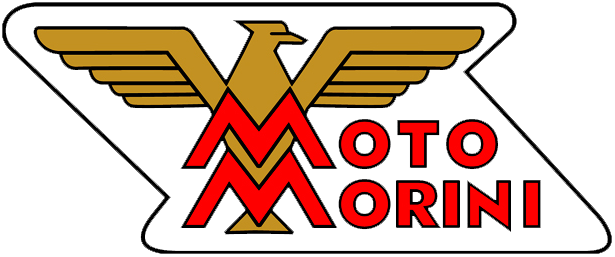 |
To the homepage |
|
|
The fastest 250cc single of the world from Italian magazine "Legend Bike", issue 139 / April 2004.On the eve of the third and last race for the 1967 Italian RR championship, which was held at the Pergusa (Sicily) racetrack, there were 3 riders fighting for the title in the 250cc class:
 So far nothing particular as their position in the championship reflects their skills.
What more surprising is the leadership by the Morini, that although many years had passed, still keeps itís fame as the "fastest 250cc single of the world".
So far nothing particular as their position in the championship reflects their skills.
What more surprising is the leadership by the Morini, that although many years had passed, still keeps itís fame as the "fastest 250cc single of the world".
All this began in 1963 with Tarquinio Provini, who was then confirmed during the following season by rising star-rider Giacomo Agostini and kept until the end of the 1967 season. Thanks to the ďpoints gapĒ which he acquired after the first 2 races, Bergamonti could set for a relaxed third race. To win the last Morini's championship title he just needed to finish second behind Grassetti who was on the Benelli 4. To reverse this situation Benelli decided to field 2 motorcycles, as well as Grassetti, they entered another 4 cylinder ridden by Renzo Pasolini, who didnít take part to the Italian RR championship due to his engagement in the World RR championship. Benelli's attempt should became vane. Although with gearbox problems, Bergamonti finished second behind Grassetti, but ahead of Pasolini (third) and Villa (fourth). The great come-back This was the last big success for a model which had started itís racing career ten years earlier and the victory sounds like a miracle as it was obtained from a bike which had remained in store for a couple of years since Agostini left Moto Morini for MV Agusta. In fact Moto Morini had stopped racing during 1965 and 1966 and their come-back in 1967 was thought as hopeless with a 4 stroke single. Although this being the true for the other singles, so far they just permitted a mere possibility to participate for privateers without any chance of success, the Morini was still able to dominate the Italian RR championship. Grassetti shocked the competition by winning the first race in 1967, but he left the Morini factory bike after his third place in the second race at Riccione returning to Benelli, at least for the 250cc class. Walter Villa is called-in to ride the left-over motorcycle comming third for the Bolognese factory.
Meanwhile the Morini staff had decided at the beginning of the Italian RR championship season to also support Bergamonti, supplying him with a 250cc DOHC factory racer. Villa was groggy after an incident during the Rimini race and Bergamonti had started a special feeling to the Morini; in fact: thanks to a special kit, developed by him (in his own workshop), many private racers could continue their racing career on the Morini Settebello overbored to 250cc. Bergamonti's debut was dazzling; during his first race for the "tricolore" (Italian RR championship) at the Vallelunga (Rome) racetrack, he was leading when the battery fails, leaving him running the last meters with a dead engine, allowing Grassetti to take the win on the finish line. Success arrives at the second race; although being faced by the two Benelli 4s of Grassetti and Pasolini, Bergamonti takes the win easily ahead of Walter Villa on his Montesa and both Benelli's suffering from mechanical failures. Thanks to this score the gap between Bergamonti on Moto Morini and his competitors, that Bergamonti has no problem taking the championship. The last year In the face of the competition of the many multi-cylinders machines, during the 1968 season, the Morini 250cc DOHC receives an additional technical upgrade, necessary to keep it at a competitive stage. The last races of the Morini 250cc are at the "Mototemporada romagnola" (downtown races held in the Romagna region), the series of races held on the down-town racetracks of Rimini and Cesenatico and also at the Imola raceway. The first race at Modena had to be stopped, due to adverse weather conditions, Bergamonti classified second at Rimini, finishing after Renzo Pasolini on his Benelli 4 cilinder. At Cesenatico Bergamonti was fourth after Ralph Brians (Honda 6), Pasolini (Benelli 4) and Phil Read on the Yamaha 2 stroke 4 cylinder. Is there still space for a single? For the out come we have to wait until the race at Imola where Bergamonti on his Morini is third, battling against Brians, Pasolini, Grassetti and the couple Read-Ivy on their Yamaha's. It's an important result, confirming how the Morini can still be named the best 250cc single. On the contrary those 3 races show that all ambitions for a victory are passed. And any additional work on the motorcycle can't help competing with the multi-cylinders taking the lead. Not only the 4 strokes but now also 2 strokes as well. At this stage, the Bolognese factory quits itís racing activities. The first DOHC After two years of racing success, let's explain how the Morini 250cc came to these results. The DOHC design had already been selected in 1956 for the factory racer, the same year as the 175 DOHC Rebello made it's first appearance. It was then a short step from the 175cc to a 250cc capacity. In 1957 the first 250cc DOHC with a capacity of 246.66 cm3, having a bore of 69 mm and a stroke of 66 mm, was entered in to competition. The distribution is driven by a chain as for the Rebello. The cylinder head and the valve guides were made from light alloy. On the right side of the cylinder head there is the gear, driven by the chain, that joins (to another 2 intermediate gears) the 2 outer gears are connected to the camshafts. These move the valves through pushrods, held into position by 2 external springs. The 29 HP (@ 10'000 rpm, compression ratio of 9.5 : 1) the fuel is supplied to the engine by two 30 mm Dell'Ortos.
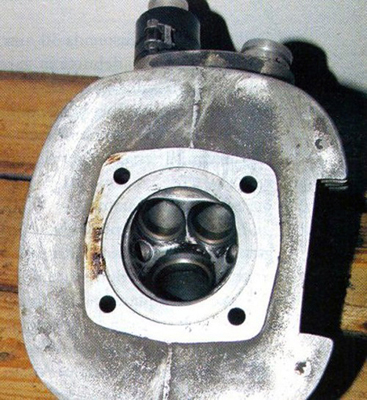 On the prototype that was on the track for the first time at the Gallarate (Varese) race, the ignition was a twin magneto, but the battery/coil version was also available.
On the prototype that was on the track for the first time at the Gallarate (Varese) race, the ignition was a twin magneto, but the battery/coil version was also available.
The engine had a dry-sump dual pump lubrication system and the primary transmission on its left side with a 5 speed gearbox (straight-cut) through a multi-plate dry clutch. Itís close relation to the Rebello can be seen from the frame; the 250 uses an open-bottom frame with an hydraulic front fork and rear suspension was by 2 hydraulic shock-absorbers. Both wheels use 19" rims. Tyres sizes at the front 2.50 and at the rear a 2.75. The dry weight is 113 kg. The new DOHC first outing was at the Monza Grand Prix of the Nations but both riders Campana and Mendogni, the riders that brought it to itís debut in Gallarate, did not finish. A new motorcycle Although itís power being at the same as the competition, the new Morini doesn't reach the expected goals, itís reliability and the narrow margins of improvement and as it can be considered as an evolution of the 175cc Rebello. To increase the performance and to remain at the top, it is necessary to design a completely new motorcycle. Then in 1958 it is decided to develop a new engine. Looking back to the model of the previous year the only common part is the DOHC, all the rest is new, starting from the fact that the new layout is designed with a vertical single cylinder based on a different bore and stroke. The concept is reinforced as an engine of "square dimensions" with 72 x 61 mm bore and stroke giving it a capacity of 248.2 cm33. 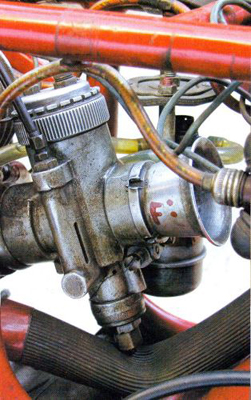
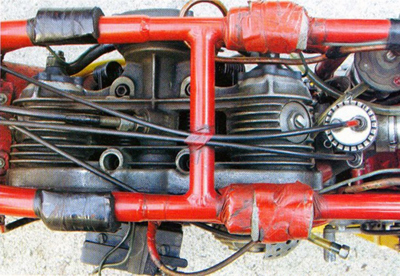 With a non-confirmed compression ratio, the maximum power of 32 HP is delivered @ 10'500 rpm.
2 sodium-coated valves (with an angle of 90į) are activated by 2 OH gear-driven (on the right side of the engine) camshafts and on needle-bearings.
The cylinder head has a hemispheric chamber and the piston has a large dome.
Ignition (2 spark-plugs one of which is 14 or 12 mm and the other 10 mm diameter) and the spark are supplied from a contact-breaker, coil and battery.
A Dell'Orto 30 mm carburetor provides the fuel to the engine, was lubricated by a double pump from a dry-sump.
The primary gear-driven transmission transfers the power through a dry clutch to a 6-speed gearbox.
The clutch drum is open in order to improve heat dispersion.
Particular care has been given to the weight reduction making the crankcases and their covers out of magnesium.
With a non-confirmed compression ratio, the maximum power of 32 HP is delivered @ 10'500 rpm.
2 sodium-coated valves (with an angle of 90į) are activated by 2 OH gear-driven (on the right side of the engine) camshafts and on needle-bearings.
The cylinder head has a hemispheric chamber and the piston has a large dome.
Ignition (2 spark-plugs one of which is 14 or 12 mm and the other 10 mm diameter) and the spark are supplied from a contact-breaker, coil and battery.
A Dell'Orto 30 mm carburetor provides the fuel to the engine, was lubricated by a double pump from a dry-sump.
The primary gear-driven transmission transfers the power through a dry clutch to a 6-speed gearbox.
The clutch drum is open in order to improve heat dispersion.
Particular care has been given to the weight reduction making the crankcases and their covers out of magnesium.
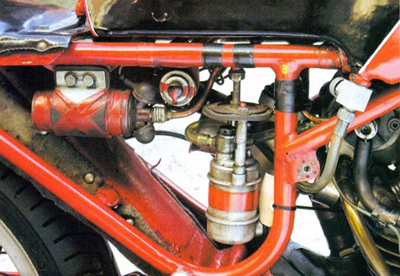
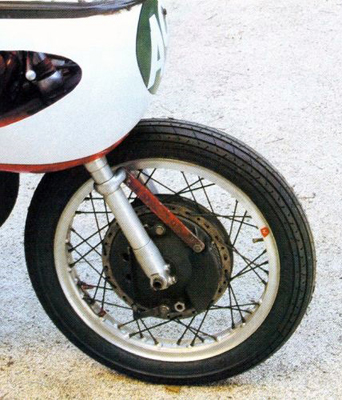
 A brand new frame
A brand new frame
The frame was also improved; it's still tube construction but this time with a closed twin cradle and central triangle. New suspension, the front fork has steel open stanchions and the rear swing-arm employs 2 different types of spring/hydraulic shock absorbers. Both wheels are made of alloy; the front is a 2.50x19'' and the rear a 2.75x19íí. The front drum 4 LS brake has a 180 mm diameter and a massive air intake on each side, at the rear there is a 2 LS drum with a diameter of 160 mm. Dry weight was now down to 108 kg and the maximum speed was up to 210 km/h. First victory The new twin-cam is officially entered at the Gran Premio delle Nazioni at Onza in 1958. It is the last race of a World RR championship dominated by Carlo Ubbiali on his MV Agusta and he wants to show his superiority in front of the crowd at his home racetrack. Moto Morini enters 2 motorcycles, one for Emilio Mendogni and the other for Gianpiero Zubani, and, at the end of the race they achieve first and second place. Mendogni takes the lead from the beginning until the end of the race, whilst Zubani overtakes Ubbiali on the finish straight and at the same time, he achieves the fastest lap.
Limiting their effort to the Italian RR championship. A couple of wins at Modena and Imola are not enough to keep the Morini name at the top of the quarter liter racers. There are still some handling problems to be solved due to the weight distribution and the rather large fairing. 1960 was the time to re-style the bike, with improvements introduced by a lowered tapered frame. A new fairing and the fuel tank, which is slimmer and longer and allows the rider to assume a more aerodynamic position. The weight is down also by installing an Oldani 2 LS front brake of smaller diameter in conjunction with a new Ceriani tele-hydraulic front fork. The engine lubrication system was changed to wet sump. Tarquinio Provini races this bike in the 1961 Italian RR championship winning all of the 5 races and taking the title whilst the Morini 250cc becomes "the fastest 250cc single in the world".
Close to the World RR championship With a motorcycle similar to the 1961 model, the following year Provini again takes the Italian championship title. This time winning 3 of the 5 races, leaving the other to Tsiaris (Moto Morini) and Grassetti (Benelli). As in 1961, Provini and his Moto Morini are only entered to a couple of the World RR championship races in 1962. In 1963 Provini had no rivals in the Italian RR championship winning again all of the 5 races, whilst in the World RR championship he come second to Jim Redman (Honda) by only 2 points. Provini and his Morini were let down by their lack of belief in their effective capabilities than by the presumed superiority of the Redman-Honda. The performance of the Morini 250cc DOHC, which had not had substantial modifications since the previous year, is still at the top in 1964 when the motorcycle is used by Giacomo Agostini. As in the previous 3 years, they win the Italian RR championship. Whilst again a reduced campaign in the World RR championship only brings a few good results. In 1965 the twin-cam is practically abandoned, just participating in a few races in the hands of Grassetti or Spaggiari. This situation is to change in 1967.
| |||||||||||||||||||